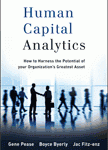 "Correlation does not equal causation"; this is true across all data analytics, including human capital analytics, and it's a concept that coauthors Gene Pease, Boyce Byerly, and Jac Fitz-enz discuss in their new book, Human Capital Analytics: How to Harness the Potential of Your Organization's Greatest Asset.
"Correlation does not equal causation"; this is true across all data analytics, including human capital analytics, and it's a concept that coauthors Gene Pease, Boyce Byerly, and Jac Fitz-enz discuss in their new book, Human Capital Analytics: How to Harness the Potential of Your Organization's Greatest Asset.
"How can we establish the connection between an investment and a business effect or say which metric drives another? What we would like to know is which investments change our business for the better," they say. They offer some basic questions to consider when making a logical case for causation:
- Can you separate out your participants and data into those who received the intervention (test group) and those who did not (control group)?
- Are there observable differences between the groups, more so than could be accounted for by random chances?
- Have you accounted for prior performance?
- Did you consider time-related changes?
- Did you look at the descriptive statistics?
- Have you considered the relationship between the metrics?
This is all well and good, you say, but what does it have to do with my company, much less my employees? Let's look at an example of human capital analytics in action:
The authors consider the case of Chrysler Academy, an organization that designs and delivers designing and sales training to consultants in the car company's network of over 3,000 dealerships. The company knew that trained consultants outsold untrained consultants by 35 vehicles per year, but couldn't prove that training was the factor responsible for those additional sales. Chrysler Academy also believed that lack of training was directly related to high turnover (dealers pay to send their consultants to training, but were reluctant to do so because of the high turnover of new consultants), but again, had no proof to leverage their services with dealers.
Chrysler Academy set out to analyze its data and determine if training could claim credit for at least part of the 35-vehicle sales increase and if it increased retention of sales consultants in a traditionally high-turnover environment.
The study considered three metrics—new vehicle sales volume, sales satisfaction scores, and sales consultant retention—against a number demographic factors such as the manager-to-consultant ration, dealer size, and customer satisfaction score.
In the end, the study found that 15.6 of the 35 additional vehicles were attributable to training and it showed an increase to a 99% retention rate for fully trained sales consultants within 90 days of their hire date. Chrysler Academy was able to prove that training had a significant, positive impact on sales and retention of new hires; it had hard evidence of ROI in training to show to business leadership and dealers.
As the authors say, "a great project does not usually come to an end after the initial analysis. Rather, it is more like the opening of a gold mine that continues to provide a wealth of information and benefit to the company."
Read the full case study on Chrysler Academy and more in Human Capital Analytics and learn how the power of optimizing your people investment today.
